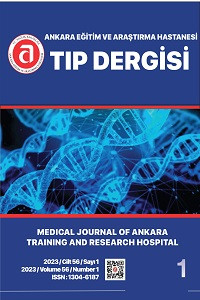Abstract
Objective: This study investigated whether delta-neutrophil index(DNI) and neutrophil/lymphocyte ratio (NLR) values have prognostic significance in wound infections after cesarean section.
Material and Methods: In this retrospective study, one hundred and ten patients who developed wound infection and were rehospitalized after cesarean section in a tertiary health center between 2015 and 2019 formed the study group. The same number of patients were in the control group; laboratory tests including DNI, leukocyte count, and percentage of neutrophils were measured 12 hours before surgery (day 0) and 24 hours after surgery (day 1). It was investigated whether these results had predictive value for wound infection.
Results: The mean age of patients included in the study was 30.6 (17-55) years, and body mass index was 28.4±3.95 kg/m2. The optimal cut-off value for NLR day 0 was 4.0, with a sensitivity of 80%, a specificity of 38.7%, a positive likelihood ratio of 1.31, a negative likelihood ratio of 0.52. Factors that were effective for the development of wound infection were NLR day 0, 1, and delta. In addition, body mass index was found to be greater than 27, number of cesarean sections was greater than one, and operative time was greater than 50 minutes and less than 30 minutes.
Conclusion: We demonstrated that NLR values during cesarean section predicted the development of infections after cesarean section.
References
- 1. Zuarez-Easton S, Zafran N, Garmi G, et al. Postcesarean wound infection: prevalence, impact, prevention, and management challenges. International journal of women's health 2017: 9; 81. 2. Olsen MA, Butler AM, Willers DM, et al. Risk factors for surgical site infection after low transverse cesarean section. Infect Control Hosp Epidemiol 2008;29(6):477–484. 3. Sinha B, van Assen S, Friedrich AW. Important issues for perioperative systemic antimicrobial prophylaxis in surgery. Current Opinion in Anesthesiology 2014; 27(4), 377-381. 4. Owens CD, Stoessel K. Surgical site infections: epidemiology, microbiology and prevention. Journal of hospital infection 2008; 70: 3-10. 5. Horan TC, Andrus M, Dudeck MA. CDC/NHSN surveillance definition of health care-associated infection and criteria for specific types of infections in the acute care setting. Am J Infect Control 2008; 36:309.
Abstract
Amaç: Bu çalışmada sezaryen sonrası yara enfeksiyonlarında delta-nötrofil indeksi (DNI) ve nötrofil/lenfosit oranı (NLR) değerlerinin prognostik önemi olup olmadığı araştırıldı.
Gereç ve Yöntemler: Bu retrospektif çalışmada 2015-2019 yılları arasında üçüncü basamak bir sağlık merkezinde yara enfeksiyonu gelişen ve sezaryen sonrası tekrar hastaneye yatırılan yüz on hasta çalışma grubunu oluşturdu. Kontrol grubunda da aynı sayıda hasta mevcuttu (n=110). DNI, lökosit sayısı ve nötrofil yüzdesini içeren laboratuvar testleri ameliyattan 12 saat önce (0. gün) ve ameliyattan 24 saat sonra (1. gün) ölçüldü. Bu sonuçların yara enfeksiyonu için prediktif değeri olup olmadığı araştırıldı.
Bulgular: Çalışmaya alınan hastaların yaş ortalaması 30,6 (17-55) yıl, vücut kitle indeksi 28,4±3,95 kg/m2 idi. NLR 0. gün için optimal eşik değeri 4.0 idi, %80 duyarlılık, %38.7 özgüllük, 1.31 pozitif olabilirlik oranı, 0.52 negatif olabilirlik oranı tespit edildi. Yara enfeksiyonu gelişimi için etkili olan faktörler olarak, NLR gün 0, 1 ve delta bulunmuştur. Ayrıca vücut kitle indeksinin 27'den büyük olması, sezaryen sayısının birden fazla, ameliyat süresinin 50 dakikadan fazla ve 30 dakikadan az olması da etkileyen faktörler olarak bulunmuştur.
Sonuç: Sezaryen sırasındaki NLR değerlerinin sezaryen sonrası enfeksiyon gelişimini öngördüğünü gösterdik.
References
- 1. Zuarez-Easton S, Zafran N, Garmi G, et al. Postcesarean wound infection: prevalence, impact, prevention, and management challenges. International journal of women's health 2017: 9; 81. 2. Olsen MA, Butler AM, Willers DM, et al. Risk factors for surgical site infection after low transverse cesarean section. Infect Control Hosp Epidemiol 2008;29(6):477–484. 3. Sinha B, van Assen S, Friedrich AW. Important issues for perioperative systemic antimicrobial prophylaxis in surgery. Current Opinion in Anesthesiology 2014; 27(4), 377-381. 4. Owens CD, Stoessel K. Surgical site infections: epidemiology, microbiology and prevention. Journal of hospital infection 2008; 70: 3-10. 5. Horan TC, Andrus M, Dudeck MA. CDC/NHSN surveillance definition of health care-associated infection and criteria for specific types of infections in the acute care setting. Am J Infect Control 2008; 36:309.
Details
| Primary Language | English |
|---|---|
| Subjects | Clinical Sciences |
| Journal Section | Research Article |
| Authors | |
| Publication Date | April 30, 2023 |
| Submission Date | September 29, 2022 |
| Published in Issue | Year 2023 Volume: 56 Issue: 1 |

